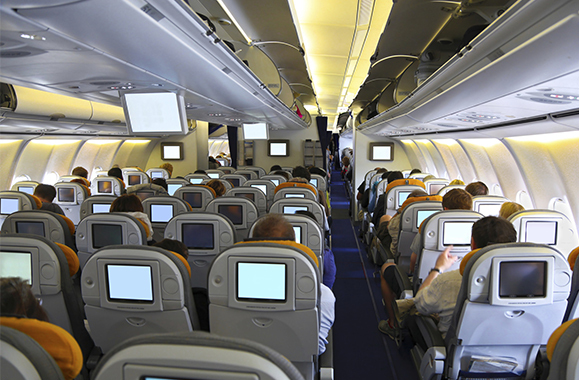If you think finding your seat and fighting for overhead space are all you need to do when you get on a plane, you could be putting your comfort (and your health) at risk. Here’s what you need to do as soon as you get on the plane.
Make Sure Your Seatback TV Works

Got a long-haul flight and don’t want to be stuck staring in to space for hours? Make sure that your seatback TV is working. If you’ve drawn the broken machine, the flight attendant may be able to move you to another seat so that you can enjoy the in-flight entertainment (instead of sadly trying to watch your neighbor’s screen).
Sanitize Your Area

There’s no gentle way to say this: Planes are gross. Microbiologists estimate that airplane tray tables have an average of 2,155 colony-forming units (CFUs, a.k.a. “germs”) per square inch. That’s compared to the 70 CFUs per square inch that lurk on airport bathroom stall locks. Pack some sanitizing wipes and wipe down your tray table, seatback TV, remote control, armrests, and seatbelt latch—basically any hard surface you’re going to touch during your flight.
Position Your Vent

Speaking of germs, if you’re trapped in an enclosed space with someone who has a contagious disease, you’ve got a pretty good chance of catching the virus. If you want to really freak yourself out, read about your chances of catching something from a sick passenger—like TB, which you can catch if you’re within two rows of patient zero; or SARS, which can transmit to flyers as far of seven rows away.
Save yourself by blowing away the germs via the air vent above your head. Set the ventilation to low or medium and position it directly in front of your head, blowing straight down. If you can feel the air flow on your lap, you’ve done it right.
Count the Rows Until the Exit

No one ever plans to be in a plane crash. But if you take a moment to mentally prepare for one, you increase your chances of survival if the worst does happen. Count the number of rows between your seat and the closest emergency exit. If the plane goes down or makes an emergency landing, you may have to make your way out of a dark, smoke-filled cabin where you can’t see the exit. If you know exactly how many rows stand between you and the exit, you can feel your way out, counting the rows by hand.
You only have about 90 seconds to evacuate a burning airplane for the greatest chance of survival, and you don’t want to waste valuable time trying to find a way out. Make sure you’ve mentally selected a back-up exit as well, in case your closest door is blocked.
Check for a Life Vest

Although the flight crew checks each seat for a life vest at the beginning of every day, they usually don’t check them between flights. Unfortunately, some people do actually steal life vests, so do a quick check under your seat for yours, especially if you’ll be flying over water.
Gather Your in-Flight Essentials

After you’ve taken care of your health and safety essentials, it’s time to focus on your in-flight comfort. If you’re stashing your personal bag in the overhead compartment, make sure to take out everything you’ll need during your flight before putting it above your seat, so that you’re not constantly getting up and down—or stranded without something you need when the seatbelt sign is on.
Put on Your Headphones

If you don’t want to talk to your seatmates, popping your headphones as soon as you sit down is the universal “no conversation please” signal. Be sure to put yours on even if you’re not listening to anything just yet. (Take them off for the flight safety demonstration, of course.)
Chew Gum

If you have sensitive ears that painfully pop during take-off or landing, chew some gum before you go airborne. This can help with air pressure changes and make you feel better. Plus, you’ll have fresher breath when you land.
Hi! I am a robot. I just upvoted you! I found similar content that readers might be interested in:
https://www.usatoday.com/story/travel/flights/2016/01/28/flight-tips/79402254/